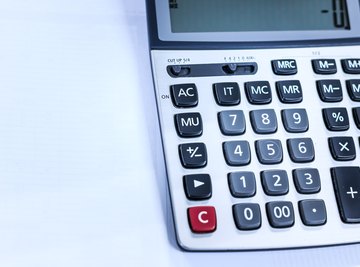
If you've ever found yourself staring at a half-eaten pie, wondering how the portion that's left compares to the size of the original pie, congratulations: You've been contemplating percentages. Although technically the term "percentage" refers to a portion out of 100, in real-world terms it really deals with how a portion of something – say, that half-eaten pie – compares to the whole. For example, one-half is equal to 50 percent, or 50 out of 100. You can use a calculator to easily work out percentages.
Double-check your answer, particularly if it seems unlikely. You may have made a calculation error at some point.
The three terms in a percentage calculation are the part, the whole, and the percentage. In the equation:
10 is the part, 40 is the whole, and 25 is the percentage. In the math world, working out percentages usually means that one of those terms is missing and you need to find it. If the question is "What percentage of 40 is 10?" you have the part (10) and the whole (40), so the omitted term is the percentage. If the question is "What is 25 percent of 40?" you have the percentage (25) and the whole (40), so the missing term is the part. Using the same logic, if the question is "10 is 25 percent of what?" the missing term is the whole.
If the omitted term is the percentage, divide the part by the whole using your calculator to determine the answer. For the example equation, this is
If your calculator has a percentage button, press it to determine the percentage. If your calculator does not have such a button, multiply your previous answer by 100 to determine the percentage:
If the omitted term is the part, use the calculator to multiply the whole by the percentage to determine the answer. If your calculator has a percentage button, the calculation is as follows:
If your calculator does not have a percentage button, you must first divide the percentage by 100:
You can then multiply this answer by the whole to determine the part:
If the omitted term is the whole, divide the part by the percentage to determine the answer. If your calculator has a percentage button, the calculation is as follows:
If your calculator does not have a percentage button, you must divide the percentage by 100 before completing the calculation:
You can then divide the part by this answer to determine the whole:
Tips
References
- "The complete how to figure it"; Darrell Huff, Carolyn R. Kinsey; 1996.
Tips
- Double-check your answer, particularly if it seems unlikely. You may have made a calculation error at some point.
About the Author
Nicole Askin has been writing since 2004. Her work has appeared in "Juice," "Ibid," and a number of websites. She is currently pursuing a degree in honors English, music and creative writing at the University of Western Ontario.
